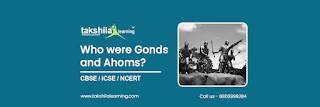Differences between Gonds and Ahoms - NCERT Class 7 History
The following are the differences between Ahoms and Gonds:
1. Ahoms were migrants from Myanmar and China's Yunnan Province who came to the Brahmaputra Valley. They were descendants of the Tai-Mongoloid people. On the other hand, the Gonds were not immigrants to the area. They lived in Gondwana, a massive continent covered in forests.
2. The Ahoms established their power by warring against various tribes' kingdoms. The Rajputs influenced the Gonds, and the Rajputs influenced the Gonds. They formed marriage connections with Rajputs in order to obtain authority and recognition. The Ahoms spoke an Assamese dialect.
3. The Gonds, on the other hand, spoke Gondi, which is a Telugu-like language. They spoke in a Dravidian dialect as well.
4. Following their conversion to Hinduism, the Ahoms began to worship Hindu gods rather than their tribal gods. On the other side, the Gonds practised both clan worship and Lord Shiva devotion.
5. In Assam, the Ahoms formed their kingdom. In modern-day Telangana, Uttar Pradesh, Andhra Pradesh, Madhya Pradesh, Eastern Maharashtra (Vidarbha), Chhattisgarh, and Western Odisha, the Gonds were discovered.
Ahoms and Gonds have some similarities.
Similarities between Ahoms and Gonds
Ahoms and Gonds have the following similarities:
1. In both circumstances, the administration was centralised.
2. Both were small tribes that grew in strength by annexing smaller villages nearby.
3. Both societies featured jatis, or class divides.
Read more

Comments
Post a Comment
Thank you we will contact ASAP.